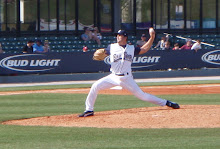
Yet another Sunday has come and gone...and Christmas is drawing near...what another great day for another Big Leaguer Breakdown. This week's subject will be Roy Oswalt for two main reasons. One, I found an outstanding slow motion video like last week's Verlander clip. And two, I think he it the best example of using your hips to draw velocity out of a smaller than average body type. Now, as the story goes with Oswalt, early in his career he had loss some of his mid-90s velocity due to some nerve impingement in his shoulder. As luck would have it however, he was working on his car one morning and was making some 'adjustments' to his car battery and was inadvertently electrocuted. Some how, through this freak accident, the impingement was alleviated and he almost immediately regained his 95mph fastball. Now, let me say, I do not condone purposefully electrocuting oneself to throw the baseball harder...I do, however, condone studying videos of Oswalt to see how he does it now.
Check out the video I am talking about of Roy Oswalt rocking and firing.
Oswalt, as I said, does not have the body type of your "prototypical" pitcher. Generally, pitchers are tall, long and lean with large powerful legs and broad backs. Oswalt on the other hand, although lean, is short and looks more like a nascar driver than a pitcher. However, lets look at the video to see how he throws his fastball in the mid-90's.
Notice immediately at the 18 second mark, that Oswalt has already begun to lock his hips and front shoulder on target. By doing so early, he has set his body in the correct position to control his hip turn until the exact right moment. Notice how both his hips and shoulder seem to lock onto target at about the same time.
One warning though, you can see as he gets his front leg to its highest point, he has already begun to leak his body weight forward. As general rule, I am not a big fan of doing so, because it generally leads to rushing by the pitcher and it usually prevents getting the elbows up on time.
If we stop the video at the 30 second mark, we see two mechanical trademarks of Roy. First off, his stride is well above average for a pitcher his size. Generally, you want your stride to be timed off your elbows getting to shoulder heights. Pushing off and trying to "jump" to the plate as Oswalt does here generally prevents good timing from the elbows. Secondly, you can see how his elbows have elevated to the power position in perfect time. His front foot hasn't quite gotten to "foot strike" but his elbows are already up and ready to begin rotating to the plate.
The next section of the video here is the most important. Rewatch the video from 30 seconds to 32 seconds and study the split second timing between his hips and his elbows. Understand that at full speed, this hip turn happens in a blink of the eye. It is almost violent to watch Roy fire his hips and bring the hand through to release point. However, it is this athleticsm that allows Roy to truly utlize every inch of power from his smaller stature. Of course, it doesn't hurt that at the 32 second mark, his chin is perfectly on target with his chest over top of his front leg with a slight bend at the knee. As we know by now, if you've read any of my other BLB's, this is essential to a pitcher being able to repeat his delivery.
So keep studying those mechanics and keep a close eye on the timing we are looking for. Oswalt is a model of that timing, even if he tends to jump a bit to his landing...this may be necessary for those vertically challenged pitchers out there.
Until next time...!!

No comments:
Post a Comment